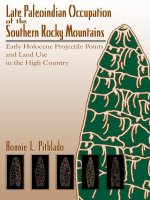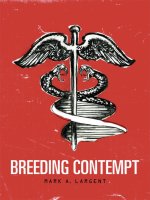university press of florida the bioarchaeology of tuberculosis a global view on a reemerging disease oct 2003
Bạn đang xem bản rút gọn của tài liệu. Xem và tải ngay bản đầy đủ của tài liệu tại đây (5.82 MB, 369 trang )
THE
BIOARCHAEOLOGY
OF TUBERCULOSIS
A Global View on a
Reemerging Disease
Charlotte A. Roberts
and
Jane E. Buikstra
University Press of Florida
Gainesville/Tallahassee/Tampa/Boca Raton
Pensacola/Orlando/Miami/Jacksonville/Ft. Myers
FROB FM ppi-xxiv 8/5/03 10:00 AM Page iii
THE
BIOARCHAEOLOGY
OF TUBERCULOSIS
Florida A&M University, Tallahassee Florida Atlantic University, Boca Raton
Florida Gulf Coast University, Ft. Myers Florida International University, Miami
Florida State University, Tallahassee University of Central Florida, Orlando
University of Florida, Gainesville University of North Florida, Jacksonville
University of South Florida, Tampa University of West Florida, Pensacola
FROB FM ppi-xxiv 8/5/03 10:00 AM Page i
FROB FM ppi-xxiv 8/5/03 10:00 AM Page ii
THE
BIOARCHAEOLOGY
OF TUBERCULOSIS
A Global View on a
Reemerging Disease
Charlotte A. Roberts
and
Jane E. Buikstra
University Press of Florida
Gainesville/Tallahassee/Tampa/Boca Raton
Pensacola/Orlando/Miami/Jacksonville/Ft. Myers
FROB FM ppi-xxiv 8/5/03 10:00 AM Page iii
Copyright 2003 by Charlotte A. Roberts and Jane E. Buikstra
Printed in the United States of America on acid-free paper
All rights reserved
08 07 06 05 04 03 6 5 4 3 2 1
Library of Congress Cataloging-in-Publication Data
Roberts, Charlotte A.
The bioarchaeology of tuberculosis: a global view on a reemerging disease / Charlotte A.
Roberts and Jane E. Buikstra.
p. cm.
Includes bibliographical references and index.
ISBN 0-8130-2643-1 (cloth: alk. paper)
1. Tuberculosis–History. 2. Tuberculosis–Epidemiology. 3. Paleopathology. I.
Buikstra, Jane E. II. Title.
RA644.T7R58 2003
616.9′95′009–dc21 2003042635
The University Press of Florida is the scholarly publishing agency for the State University
System of Florida, comprising Florida A&M University, Florida Atlantic University, Florida
Gulf Coast University, Florida International University, Florida State University, University
of Central Florida, University of Florida, University of North Florida, University of South
Florida, and University of West Florida.
University Press of Florida
15 Northwest 15th Street
Gainesville, FL 32611–2079
FROB FM ppi-xxiv 8/5/03 10:00 AM Page iv
To the women of Africa burdened by both tuberculosis and HIV;
Keith Manchester, whose enthusiasm for palaeopathology
at the outset guided Charlotte into this field; and
Gerrett B. (Grandpa) Buikstra, whose encouragement
was essential to Jane’s choice of career.
FROB FM ppi-xxiv 8/5/03 10:00 AM Page v
FROB FM ppi-xxiv 8/5/03 10:00 AM Page vi
CONTENTS
List of Figures ix
List of Tables xiii
Preface xvii
Acknowledgments xxi
1. Reemerging Infectious Diseases
Tuberculosis Is One of Many
1
2. Tuberculosis
A Disease of Poverty and More
44
3. Tuberculosis in the Old World
Absence of Evidence Is Not Evidence of Absence
87
4. Tuberculosis in the New World
An Interpretative Challenge
187
5. To Cure Sometimes, to Relieve Often, to
Comfort Always
The Written and Illustrative Evidence for Tuberculosis,
Its Diagnosis, and Its Treatment
214
6. The White Plague Continues
262
Glossary 273
Bibliography 279
Index 333
FROB FM ppi-xxiv 8/5/03 10:00 AM Page vii
FROB FM ppi-xxiv 8/5/03 10:00 AM Page viii
ix
FIGURES
.. Tuberculosis alert campaign 3
.. Person sneezing showing the droplets created 7
.. “No Spitting” sign, Oakworth Station, West Yorkshire 8
.. Possible course of events following primary infection with the
tubercle bacillus 9
.. U-shaped curve of concern 18
.. The types of tuberculosis, risk factors, and vulnerable groups
(Vietnamese population) 27
.. The Piot model of the treatment process in tuberculosis 33
.. Personal and environmental factors affecting drug compliance in
India 38
.. Estimation of the protection effect of BCG vaccination 41
.. The Brontë sisters, Charlotte, Emily, and Anne 53
.. Relationship between four indices of poverty and rate of
tuberculosis 59
.. Average number of hours of bright sunshine per day in the British
Isles 65
.. Mean daily sunshine: England and Wales, Scotland, and Northern
Ireland 66
.. Seasonal trends in deaths in London, 1845–74 66
.. Relative movement of tuberculosis across the globe,
1800–1850 67
.. Relative movement of tuberculosis across the globe,
1950–90 67
.. Temporary accommodation for migrant workers in India 68
.. Miners of Kuttenberg, by Matthaus of Kuttenberg, c. 1490 70
.. Collecting cocoons and weaving silk 73
.. Dairy produce for pastoralists in Xingjiang, China 76
.. Dung piles and yurts, Xingjiang, China 77
.. Skeletal distribution of tuberculosis 90
FROB FM ppi-xxiv 8/5/03 10:00 AM Page ix
.. Skeleton of 25-year-old female with tuberculosis 91
.. Psoas major muscle origin and insertion points in the
skeleton 93
.. Tuberculosis of spine in an African woman 94
.. Possible tuberculosis of pubic symphysis 98
.. Pelvic girdle with new bone formation 99
.. Tuberculous destruction of the skull 101
.. Lupus vulgaris of the neck 102
.. New bone formation on the endocranial surface of the
skull 103
.. New bone formation on the ribs 104
.. New bone formation on a rib, in cross section 104
.. Rib involvement in pulmonary disease 106
.. Terry Collection: frequencies of new bone formation on ribs 106
.. Age profile of individuals with new bone formation on ribs 107
.. New bone formation on rib from a pig (archaeological) 108
.. Calcified pleura 109
.. Radiograph of spinal tuberculosis 111
.. St. Helen-on-the-Walls, York: later Medieval cemetery plan 113
.. Milking a cow 120
.. Plowing in China 121
.. Butchery of a pig 122
.. Reconstruction of a late medieval longhouse, Wharram Percy,
England 123
.. Milking sheep in Syria 124
.. Skeleton in grave showing post-mortem damage to trunk 126
.. Juvenile vertebral bodies showing remnant holes from normal
development 128
.. Map of definite British cases of tuberculosis 133
.. Cirencester S: tuberculosis of lumbar vertebrae 139
.. Cirencester 704: probable tuberculosis of the left knee 140
.. Bedhampton 69: spinal tuberculosis 141
.. Raunds 5218: tuberculosis of the spine 142
.. Addingham 134: spinal tuberculosis 142
.. aDNA gel of Addingham 134 143
.. Mycolic acid profile from Addingham 134 144
x Figures
FROB FM ppi-xxiv 8/5/03 10:00 AM Page x
.. Sewerby: plan of skeleton from the cemetery 145
.. St. Oswald’s Priory: probable tuberculosis of the right hip 146
.. The Stagecoach, by Hogarth 146
.. Death rates from tuberculosis, 1850–1950 147
.. Possible lupus vulgaris affecting the frontal bone 148
.. Mummy of Nespereha¯n, Thebes 163
.. Carving on a false door of a tomb 164
.. Clay statuette of an emaciated man with angular kyphosis 165
.. Spinal tuberculosis from Arene Candide, Italy 175
.. Cause of death data from Coimbra, Portugal, 1910–36 177
.. Map of countries with tuberculosis cases in Europe 184
.. Map of suggestive skeletal tuberculosis in the Western
Hemisphere 191
.. Histogram of the distribution of ancient tuberculosis cases through
time 194
.. Pott’s disease of the spine, Norris Farms site 202
.. Proliferative rib lesions, Norris Farms site 203
.. Spina ventosa, Norris Farms site 204
.. Relative percentage of affected individuals compared to overall age
distribution, Norris Farms site 205
.. Comparison of relative percentages of individuals affected by
resorptive and proliferative costal changes, Norris Farms site 205
.. Individuals with lytic lesions, Norris Farms, Schild, and Estuquiña
sites 208
.. Map of tuberculosis worldwide, excluding Europe 213
.. London Bills of Mortality for 1665 217
.. Angel of death 220
.. Pictographs from Arizona caves 223
.. Kokopelli 224
.. Patient treated at Stannington Children’s Sanatorium 230
.. Children enjoying sunlight, Stannington Children’s
Sanatorium 231
.. Sanatorium in Keighley, West Yorkshire 231
.. Dr. Edward Livingstone Trudeau, 1885 237
.. Little Red 241
.. Lung tissue affected with tuberculosis 256
Figures xi
FROB FM ppi-xxiv 8/5/03 10:00 AM Page xi
.. Men-an-Tol, Lanyon, Cornwall 257
.. Tuberculosis huts in Mammoth Cave, Kentucky 258
.. People touched for the King’s Evil 259
.. Touching for the King’s Evil 259
.. Royal touch pieces 260
xii Figures
FROB FM ppi-xxiv 8/5/03 10:00 AM Page xii
TABLES
.. Species of mycobacteria capable of affecting humans 6
.. Timetable of tuberculosis 9
.. The leading causes of death worldwide 11
.. Deaths per annum of people aged 5 years or more from infectious
and parasitic diseases and external aid given for their control 11
.. The global toll of TB in 1997 15
.. Risk factors in tuberculosis 21
.. Vietnamese refugees’ beliefs about causes of tuberculosis, New
York State, 1994 24
.. Vietnamese refugees’ beliefs about ways of preventing tuberculosis,
New York State, 1994 25
.. Risk factors for weak lungs–tuberculosis in the Philippines 26
.. Symptoms associated with weak lungs–tuberculosis in 50 adults in
the Philippines 26
.. Sidama concepts and causes of tuberculosis in Ethiopia 28
.. Sidama opinions of symptoms of tuberculosis in Ethiopia 28
.. Best prophylactic measures against tuberculosis in the Sidama
population 28
.. Conventional drugs used in TB treatment 34
.. Components of the deprivation indices and weightings on each
component 61
.. Anxiety through the year of the Massa and Mussey of Africa 72
.. Workload distribution through the year of the Massa and Mussey,
Africa 72
.. Cattle tuberculosis figures for 1997–March 2000 for England,
Wales, and Scotland 75
.. Survival times of M. bovis under different environmental
conditions 79
.. Regional distribution of bone and joint tuberculosis in 160
patients 92
xiii
FROB FM ppi-xxiv 8/5/03 10:00 AM Page xiii
.. Number of vertebrae affected in tuberculosis 95
.. Differential diagnosis of spinal damage in tuberculosis 96
.. Differential diagnostic features of pyogenic arthritis and
tuberculous arthritis 97
.. Summary of data from studies of rib lesions 105
.. Correlation of radiological findings and changes in tuberculosis of
the spine 112
.. Domesticated species commonly found in modern Europe, with
probable wild ancestors, region of origin, and approximate date of
earliest domestication 115
.. Tuberculosis in the British Isles 134
.. Nonspecific changes in British skeletal material 137
.. Tuberculosis in Hungary 152
.. Tuberculosis in Lithuania 155
.. Mycobacterium tuberculosis DNA in skeletons from Lithuania 157
.. Tuberculosis in Poland 159
.. Tuberculosis in Russia 160
.. Spinal tuberculosis in Egypt 167
.. Tuberculosis in France 168
.. Tuberculosis in Italy 174
.. Tuberculosis in Spain 178
.. Tuberculosis in Japan 181
.. Tuberculosis in Hawaii 182
.. Earliest cases of Old World tuberculosis in skeletons/mummies
183
.. Sites with evidence of ancient tuberculosis in the New World
195
.. Causes of death at the end of the Victorian Period 218
.. Standard diets for males and females at King Edward VII
Sanatorium 233
.. Super diet for tuberculous patients, Coimbra, Portugal,
early 20th century 235
.. Daily routine for sanatorium patients 244
.. Daily cost of food for treatment of pulmonary
tuberculosis 249
.. Ethnobotanical remedies for tuberculosis in Ethiopia 253
xiv Tables
FROB FM ppi-xxiv 8/5/03 10:00 AM Page xiv
.. Herbal remedies recommended today for pulmonary
disorders 253
.. Herbal remedies recommended by Culpeper for pulmonary
disorders 254
.. Herbal remedies recommended for pulmonary disorders in Native
American medicine 255
Tables xv
FROB FM ppi-xxiv 8/5/03 10:00 AM Page xv
FROB FM ppi-xxiv 8/5/03 10:00 AM Page xvi
PREFACE
Tuberculosis (TB) as a disease has caused so much human suffering, and so
much has been written already about it, over such a long time, that readers
may be wondering why we want to write yet another book on the subject. In
a way, the study of how disease affects human populations has always had a
fascination for us. The reconstruction of past human behavior does not
stop at death because, as Dormandy (1999: xiii) points out, death “is a part
of life: it is the most predictable and the most hum drum of biological
milestones.” Therefore, as people die because they suffer from disease or
trauma, there is a distinct relationship between the two that cannot be sepa-
rated. “Disease,” furthermore, “has always been present in society and it
will remain part of all societies in the future” (Mayer 2000: 938), and dis-
ease has shaped, and will continue to shape, people’s sociopolitical and eco-
nomic situations. Being unhealthy is detrimental to “normal” functioning.
So why concentrate on tuberculosis in particular, both of us having much
broader interests in biological anthropology?
In 1976, Charlotte Roberts, then a student nurse, was surprised to find
herself nursing a patient with tuberculosis. Surprised because earlier in the
20th century, a vaccination and antibiotics to deal with tuberculosis had
been developed. Tuberculosis as a major cause of morbidity and mortality
had declined considerably as a result both of these developments and of
improvements in living conditions during the 20th century. Why this man
had contracted tuberculosis is not recalled, but, as will become clear in this
book, there could have been a whole range of reasons. He died not long
after being admitted to hospital; he was in his fiftieth year. That first expe-
rience of dealing with a living person with tuberculosis was extended
(through a career change) by work on skeletal remains from archaeological
sites in Britain in the 1980s. Roberts was particularly interested in present-
day diseases that were common in the past as well as in disease loads in the
poorer parts of populations. If we believe the documentary data, tuberculo-
sis certainly has been a major contributor to illness and death throughout
history, and the conditions for its appearance have been clearly present.
For example, high population density, the development of agriculture,
overcrowding, specific work patterns, poverty, nutritional deprivation, and
xvii
FROB FM ppi-xxiv 8/5/03 10:00 AM Page xvii
depressed immune systems all contributed to enabling tuberculosis to
spread from animal to human and human to human. During those 1980s
research years, however, it was noted that the evidence for tuberculosis in
skeletal material from British funerary contexts was very scarce compared
to the historical data (Manchester and Roberts 1986). Subsequent work
also suggested that the criteria for identification of the infection in the
skeleton needed refining (Roberts et al. 1998).
Jane Buikstra's interest in the disease also arises from a combination of
personal engagement and intellectual enquiry. Her paternal grandfather,
Gerrett B. Buikstra, immigrated as a boy from Friesland in the Netherlands
to the United States following the death of his father from tuberculosis.
Buikstra's study of the infection began in the late 1960s, when she was
engaged in the investigation of tuberculosis among historic period skeletal
remains of the Caribou Eskimo from the Barrengrounds of Canada as part
of a project directed by Charles J. Merbs (Buikstra 1976). Since that time
she has extended her research to midcontinental North America and the
west-central Andes, particularly focusing on where, why, and when the
disease occurred in the New World (Buikstra 1977, Buikstra and Cook
1978, Buikstra 1981, Buikstra and Williams 1991, Buikstra 1999). Recent
work has identified tuberculosis in human remains from South America
using ancient microbial DNA (Salo et al. 1994). Thus, both of us came to
the study of tuberculosis at approximately the same time, influenced by
both intellectual curiosity and personal history.
Clearly, we had a common interest, and it seemed reasonable to come
together and to collate information on the history of tuberculosis into a
book. In addition, it became apparent that tuberculosis was again becoming
a problem. Indeed, in 1993 the World Health Organization declared that
TB was a global emergency (Grange 1999: 3). Reemergence of infectious
disease has, since, become a hot topic of discussion and has highlighted the
contributing problems, particularly how people interact with their environ-
ment and whether health care systems are working. The movement of
people as a result of conflict, pressure on resources, work requirements,
famine, religious persecution, and increased travel have exposed human
populations to new infectious diseases (Kaplan 1988). Pathogens causing
infectious disease may also change and become more or less virulent or
develop new ways of transmitting themselves, while people's immune
systems may be compromised by any number of factors, thus making them
more susceptible to disease generally (Morris and Potter 1997).
Of course, many books have been written on tuberculosis, and each
tends to take a different focus. For example, historically based texts trace
the rise and fall of the infection (e.g., Crawfurd 1911, Ryan 1992,
xviii Preface
FROB FM ppi-xxiv 8/5/03 10:00 AM Page xviii
Rosencrantz 1994, Feldberg 1995, Dormandy 1999) and its incidence in
specific countries (e.g., Rothman 1994, Johnston 1995). Clinically based
volumes concentrate on the epidemiology, pathogenesis, and diagnosis of
tuberculosis (e.g., Bloom 1994, Davies 1998c). For many who have written
more recently about the disease, the focus has been on documenting tuber-
culosis over the last 200 years, when historical data has been plentiful, but
for people working with the evidence for tuberculosis in the distant past
using archaeological data, a window on this infection has been provided
and its effects on the population considered.
In archaeological contexts little has appeared on the tuberculosis book-
shelf (apart from Pálfi et al. 1999), the evidence for tuberculosis in human
remains usually being reported as individual case studies. This book aims
to take a multidisciplinary approach to tuberculosis, placing it in the con-
text of today and considering the evidence for it, both primary (human
remains) and secondary (written and artistic representation). In this way it
is hoped that the extant evidence, in all its forms, will be fairly represented
and assessed. Tuberculosis more than adequately reflects the many facets of
how and why many diseases occur. Stead et al. (1995) goes further and
suggests that the history of tuberculosis is very important for modern
medicine and public health because the knowledge we can gain from the
study of the past, that is, how Mycobacterium tuberculosis spread around the
globe over time, will ultimately contribute to an understanding of the
current epidemiology of tuberculosis. It may also provide us with help in
studying resistance to M. tuberculosis using genetic control.
This book is divided into two parts, the first dealing with what we know
of the infection today, and the second with its history, diagnosis, and
prevalence through time, with a final chapter on the future of this infectious
disease.
xix
Preface xix
FROB FM ppi-xxiv 8/5/03 10:00 AM Page xix
FROB FM ppi-xxiv 8/5/03 10:00 AM Page xx
ACKNOWLEDGMENTS
Many people have helped us with this book in a multitude of ways, some
through support and encouragement, and others in more substantial ways.
Charlotte Roberts would particularly like to thank Keith Manchester, who
introduced her to tuberculosis in antiquity, and the Science and Engineer-
ing Research Council (SERC), Wellcome Trust, and Nuffield Foundation,
which have helped over the years with funding of research on tuberculosis
in Britain. Similarly, Jane Buikstra would like to thank Charles (Chuck) J.
Merbs for providing her with the opportunity to study tuberculosis in
Eskimo populations.
Many colleagues have also given generously of their data, published and
unpublished, and helped us track down the more obscure references. Any
omissions of skeletal tuberculosis cases rest solely with us, but Paleopathol-
ogy Association members have been incredibly helpful, giving freely of their
time. We thank the following people for their help, advice, and some data
from their home countries: Ana Luisa Santos (Portugal); Anagnosti Ageler-
akis, Bob Arnott, Chryssa Bourbou, and Sevi Triantaphyllou (Greece);
Ebba Durring (Sweden); Pia Bennike (Denmark); Per Holck and Berit Sell-
evold (Norway); Heikki Vuorinen (Finland); George Maat (the Nether-
lands); Philip Masy (Belgium); Joel Blondiaux, Olivier Dutour, Gyorgy
Pálfi, and Marc Pavaut (France); Maria Teschler-Nichola and Karin
Witschke-Schrotta (Austria); Elisabeth Langenegger and Frank Ruhli
(Switzerland); Alessandro Canci (Italy); Joaquim Baxarias, Lourdes Her-
rasti, and Ana Luisa Santos (Spain); Marija Djuric-Srejic (Yugoslavia);
Judyta Gladykowska-Reczecka (Poland); Gyorgy Pálfi (Hungary); Riman-
tas Jankauskas (Lithuania); Andreas Nerlich, Michael Schultz, and Albert
Zink (Germany); Anthea Boylston, Don Brothwell, Andrew Chamberlain,
Mary Lewis, Simon Mays, Ann Stirland, and Bill White (U.K.); Alexandra
Buzhilova (Russia); Ann Katzenberg and Shelley Saunders (Canada);
Michael Pietrusewsky and John Verano (United States); Miho Tanihata
(Japan); Soren Blau (United Arab Emirates and Australia); Hallie Buckley,
Kate Domett, and Nancy Tayles (New Zealand and Thailand); Marc
Oxenham (Vietnam); Peng Long-Xiang (China); Nara Bazarsad (Mongo-
lia); Stephen Webb and Judith Littleton (Australia); Jerry Rose (Jordan);
xxi
FROB FM ppi-xxiv 8/5/03 10:00 AM Page xxi
Piers Mitchell and Joe Zias (Israel); Eugen Strouhal (Egypt and Czech
Republic); Ana Luisa Santos (sub-Saharan Africa); Carmen Pijoán and
Josefina Mansilla (Mesoamerican data and references for accounts of
hunchbacks and dwarfs); Robert Pickering and George Gill (western Mex-
ico); Felipe Cardenas and Rudolph de Hoyo (Colombia); and Patty Crown
and Wirt Wills (southwestern United States). Robert Jurmain and Lynn
Kilgore (United States) provided help on information on tuberculosis in
nonhuman primates, and Keith Dobney and Angela Gernaey (U.K.) on
archaeologically derived nonhuman tuberculosis. Kevin MacDonald (U.K.)
helped on the date of cattle domestication in Egypt, and Clara Lau pointed
us to a recent paper on botanical remedies for tuberculosis. Jacqui Huntley
(University of Durham, England) also helped on identification of common
names for some botanical remedies. Peter Atkin (Geography, University of
Durham) was generous in providing published and unpublished papers on
his work relating to bovine TB. Last but not least, Ana Luisa Santos, espe-
cially, gave freely of her time when she was also completing her doctorate
degree (on tuberculosis).
Acknowledgments also go to the following people and organizations
who have provided illustrations and/or permissions for this book: the
American Review of Respiratory Disease, the Austrian National Library (Monika
Jagos), the Bodleian Library, the British Library Picture Library (Chris
Rawlings), the British Medical Journal, Elsevier Science, English Heritage
Photo Library (Cathy Houghton), Sergei Gitman and PHRI, Imperial
College Press, McGraw-Hill, Inc., George Milner, the National Portrait
Gallery (James Kilvington), Northumberland Health Authority (Stephen
Singleton), Oxford University Press, the Royal College of Physicians, the
Royal Society of Hygiene and Tropical Medicine, Springer Verlag, Charles
C. Thomas Publishers, the Trudeau Institute Archives, the Victoria and
Albert Museum Picture Library (Martin Durrant), the Wellcome Trust
Medical Picture Library (Helga Powell), the National Museum of Health
and Medicine, Washington, D.C. (Paul Sledzik), and the York Archaeolog-
ical Trust (Glenys Boyles). Pia Bennike, Anthea Boylston, Peter Davies,
John Grange, Ian Dewhirst, Ron Dixon, Vincenzo Formicola and the
Soprintendenza Archeologica Della Liguria, Robert Jurmain, Lynn Kilgore,
David Minnikin, and Angela Gernaey, Bruce Ragsdale, and Peter Rowley-
Conwy also provided images for which we are grateful.
Pam Graves gave illustration inspiration; Jean Brown, while Charlotte
Roberts was still at Bradford, produced some of the bone photographs;
and Yvonne Beadnell, Phil Howard, and Trevor Woods (Archaeology,
Durham), the Photography Department (Biological Sciences, Durham), and
the Design and Imaging Unit, University of Durham, helped with produc-
xxii Acknowledgments
FROB FM ppi-xxiv 8/5/03 10:00 AM Page xxii
ing and reproducing figures. In New Mexico, Alicia Wilbur, Lisa Hoshower,
Chris Stojanowski, Ken Nystrom, Paula Tomczak, Gordon Rakita, and
Kevin O’Briant helped Jane Buikstra with many aspects of the New World
data and Alicia very kindly took on the job of indexing the book. Despite
the library at the University of Durham being excellent, interlibrary loans
were a godsend, and many thanks go to their efficiency with a smile. We
commend the University Press of Florida, Meredith Morris-Babb and Judy
Goffman particularly, for their efficiency and help during the editorial
process.
Charlotte Roberts thanks her colleagues in the Department of Archaeol-
ogy, University of Durham, for enabling her to settle into a new job and
allowing her the time to write. Lastly (but certainly not least), thanks from
Charlotte to Stewart for supporting her and having faith in her crazy life!
Acknowledgments xxiii
FROB FM ppi-xxiv 8/5/03 10:00 AM Page xxiii
FROB FM ppi-xxiv 8/5/03 10:00 AM Page xxiv









